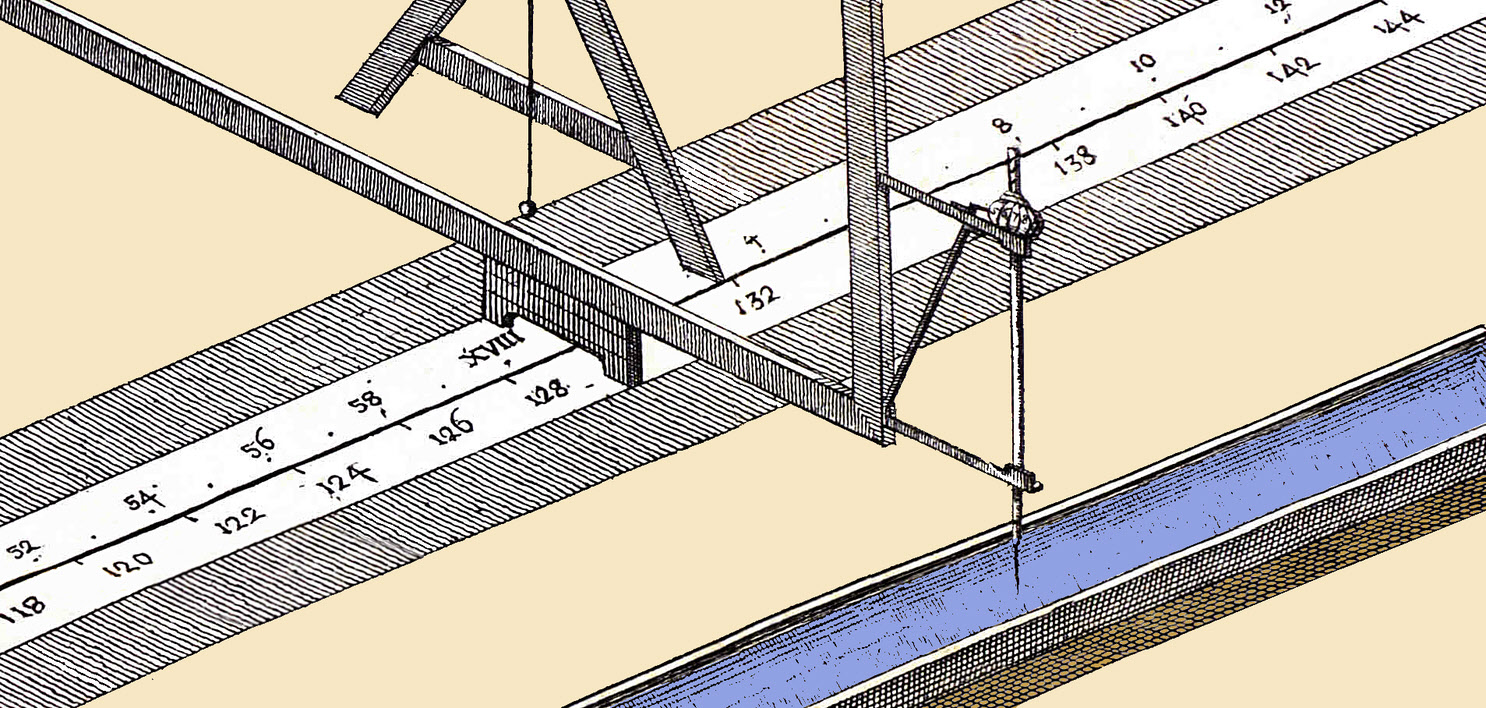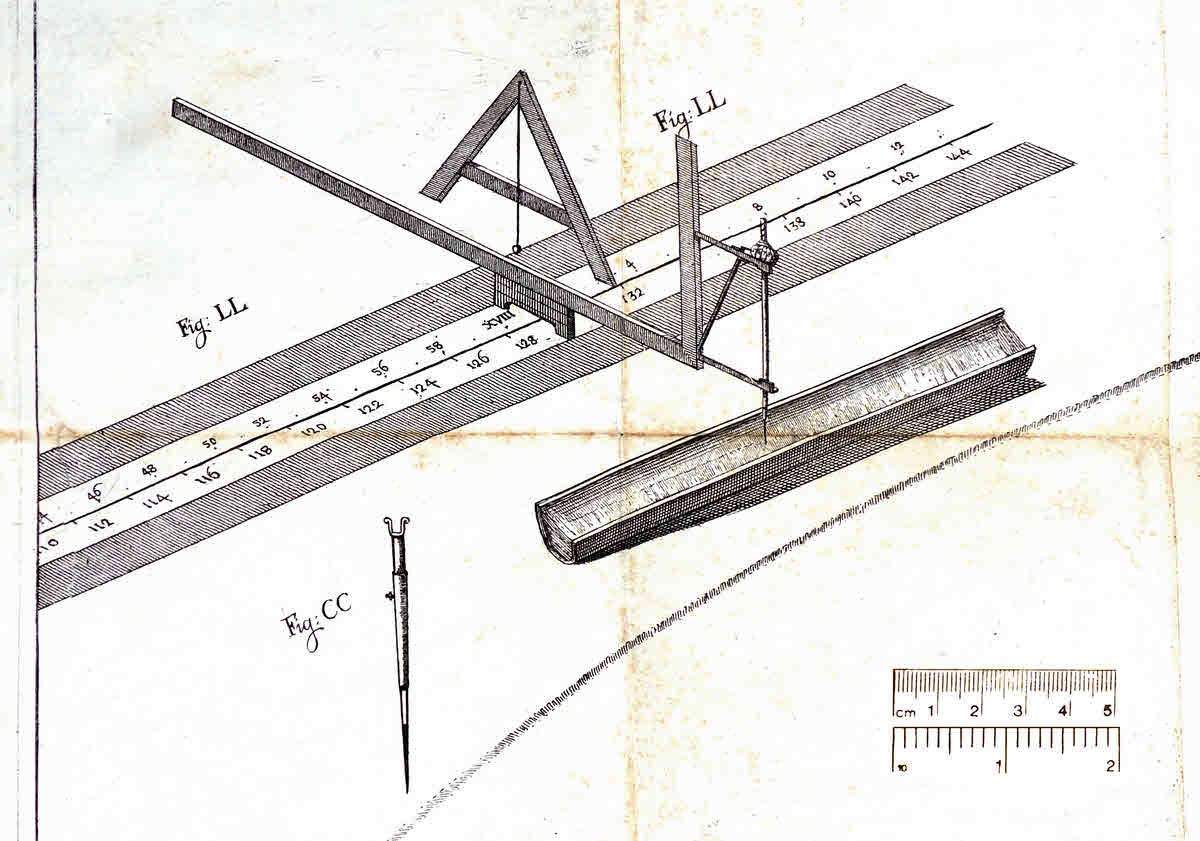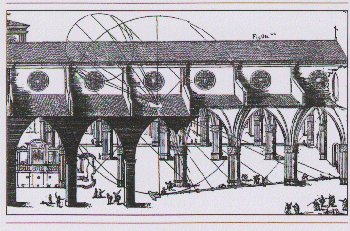
Measuring is essential to any scientist.
This page has a way to go. I none the less hope you will find that it has enough Good Stuff to repay you your time.
In 1655, Giovanni Domenico Cassini gained permission to poke a hole in the roof of the Basilica of San Petronio in Bologna, and to implant a brass strip in the basilica's floor. He was 30 years old, and would live for another 57 years, making important contributions in astronomy, engineering, and related fields. He created an important map of France, one of the first to be done by an important new technique which improved the accuracy of maps when it was used.
But it was all exceptionally carefully done. The brass strip runs as close to (true) North/South as Cassini could achieve. The hole in the roof is in just the right spot to make the image of the sun on the basilica floor cross the brass strip at the moment of local solar noon.
Who cared? For the first time, a measuring instrument of sufficient resolution and precision had been made to settle the question: Does the sun go around the earth or the earth around the sun? And this Mattered to people, because, for them, the latter seemed to suggest that you couldn't take the bible to be literal Truth, and this greatly upset them. In those days, people were killed for disputing the idea. But these are matters for another time.
Among the many things Cassini had to make as right as he possibly could was to make the top surface of the strip of brass "horizontal". Have you ever really thought about what we mean by "horizontal"? You might say that a horizontal line is "a line which is perpendicular to the path a falling object would follow". Well. Almost.
Strictly speaking, and I suspect that Cassini's horizontal line measurably recognizes this, a horizontal line is a curved line. (Exercise for the reader: The line is 66.8 m long. How far above the straight line joining its ends should the middle be?)
A story for another day: First Cassini had to decide exactly where his line had to be. He was only just able to "squeek" it between some of the pillars of the basilica. (Of course, where he put the hole mattered. Each choice affected the other. How he found "the right places" I have yet to even try to figure out!)
Once he'd found The Right Place, he then set about putting is brass (or is it bronze?) strip into the floor of the basilica.
As I said... he wanted it as close to horizontal as he could make it. Happily, the masons who laid the flag stones had done a good job. (Or perhaps Cassini had large sections relaid! But, whichever, the line doesn't protrude significantly above or below the floor, and there are no "steps" anywhere nearby.
But how to achieve the final, even-better-than-the-nearly-horizontal floor?
He used water! (Or was it mercury? A liquid, in any case.)
I hope the following detail, together with the wider view further down the page, will help you understand Cassini's method. This view has been "cleaned up" and colored. Maybe the later view, even with it's acquired blemishes, gives you a better idea of how gorgeous the engraving is. It is over 300 years old; I think a few blemishes can be overlooked?

Cassini laid something like the gutter you would see along the bottom edge of a roof, stopped up at both ends, on the floor of the cathedral, next to where he was embedding the brass strip.
With the tool shown in the illustration, he "copied" the level of the surface of the liquid in the trough to the upper surface of the strip.
I hope you too will find the illustration gorgeous, quite apart from its significance to the history of science.
(Exercise for the reader... Even with the clever trough and tool, what challenges did Cassini still face? How might they be managed? A simple enough idea in theory. Perhaps hard in practice. Did he set the strip into the floor a bit "high", and then grind it down?)
The illustration is just one small part of a magnificent plate, almost 2 meters long, one of the longest in any book of that era, or for some time to come. It gives more details of the construction of the meridian line.
I am grateful to Nigel Phillips, Rare Books, Hampshire for allowing me to photograph the illustration. If you collect books, and you have been looking for a copy of Zanotti's La Meridiana del tiempio di San Petronio (with which Cassini's book and plate is bound), if you have come across this in time, then you have only to contact Mr Phillips. Please, of course, make your own inspection before spending the very reasonable (for what it is) £3200 on this beautiful and important work. (I have "air-brushed" my upper illustration very considerably, and the lower one a little, to remove a few minor distractions.)
Here is a larger view of this small insert in the much larger plate... about an eighth of the length of it, and not even all of the height.

As I said, the illustration above is just a small part of a splendid plate. The overall plate loses almost all of its magic when presented at the small scale below, but, if you promise to remember that if you could zoom in you would find the same detail everywhere, here is a indication of what the whole thing looks like...

The bit I've presented in detail is at the upper left. Imagine that exquisite detail in the other parts, too.

There was a nice discussion of the heliometer (I learned the from the site) at https://cis.alma.unibo.it/NewsLetter/090496Nw/Heilbron.htm. That page also has a nice diagram, taken from a second plate in the book I mentioned, of how the meridian line was "squeezed in" between the basilica's pillars. The image to the right was there, from the same book as the other things on this page. (You have to use the Wayback Machine to see the page now, as far as I've been able to discover.)
If you are interested, here's a link to few notes and photos arising from a tourist visit to Cassini's meridian line, St Petronio, Bologna. The material about the line is about 3/4s of the way down that page.
The meridian was also been used to measure the moon's elevation in the sky.
Search across all my sites with the Google search button at the top of the page the link will take you to.
Or...
|
|||
| search engine by freefind |
The search engine merely looks for the words you type, so....
I have other sites. My Google custom search button will include things from them....
One of my SheepdogGuides pages.
My site at Arunet.
![]() Page has been tested for compliance with INDUSTRY (not MS-only) standards, using the free, publicly accessible validator at validator.w3.org. It passes in some important ways, but still needs work to fully meet HTML 5 expectations. (If your browser hides your history, you may have to put the page's URL into the validator by hand. Check what page the validator looked at before becoming alarmed by a "not found" or "wrong doctype".)
Page has been tested for compliance with INDUSTRY (not MS-only) standards, using the free, publicly accessible validator at validator.w3.org. It passes in some important ways, but still needs work to fully meet HTML 5 expectations. (If your browser hides your history, you may have to put the page's URL into the validator by hand. Check what page the validator looked at before becoming alarmed by a "not found" or "wrong doctype".)